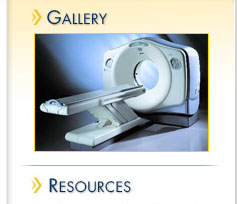| |
Two-Dimensional Echocardiogram (2D Echo)
What is 2DEcho?
-
It is a test in which ultrasound is used to picture out the heart. It is capable of displaying a cross sectional “slice” of the beating heart, including the chambers, valves and the major blood vessels that exit from the left and right part of the heart.
- “Doppler” is a special part of the ultrasound exam that assesses blood flow (direction and velocity). Doppler exam shows the flow of blood as it makes its way through and out of the heart. One would hear “swishing” or “whooshing” sounds during this part of the procedure.
What information does Echocardiography and Doppler provide?
- Echocardiography is an important tool in providing the doctors with important information of the following:
- Size of the chambers, dimension, volume and the thickness of the walls.
- Pumping function: one can tell if the pumping power of the heart is normal or reduced to a mild or severe degree.
- Valve function: it identifies the structure, thickness and movement of each heart valve.
- Volume status: Low blood pressure can occur in the setting of poor heart function but may also be seen in reduced volume of circulating blood.
- Others: “pericardial effusion” or fluid in the pericardium (the sac that surrounds the heart), congenital heart disease, blood clots or tumors within the heart, active infection of the heart valves, abnormal elevation of pressure within the lungs.
How is 2D Echo done?
What are the preparations for echocardiography?
- Sticky patches or electrodes are attached to the chest and shoulders which are connected to an electrocardiogram (ECG) machine. Patients with hairy chest may require shaving so the electrodes can adhere better for good quality electrocardiogram or ECG. These attachments record the ECG during the echocardiography test.
- Clothing that covers the chest is removed and covered by a gown or sheet to keep patient comfortable and keep private parts from exposure.
How long does 2DEcho take?
- A brief exam in a simple case may be done within 20-30 minutes. However, it may take up to an hour when there are multiple heart problems or when there are technical problems (for example, patients with lungs disease, Obesity, restlessness, and significant shortness of breath may be more difficult to image). The additional use of Doppler may add an additional 10-20 minutes.
How safe is echocardiography?
- It is extremely safe. There are no other special preparations and no known risks from the clinical use of the ultrasound in this type of testing.
|
| |
|
|
| |
|

| |
2D Echo
An Echocardiogram helps evaluate
various problems with the heart
and its function. It gives
information about the heart’s
structure and blood flow non-
invasively.
|
| |
CT Scan
A special X-Ray that creates cross
sectional pictures of your body.
|
| |
MRI Scan
An MRI scan is a radiology
technique that uses magnetism,
radio waves, and a computer to
produce images of body structures.
|
| |
Ultra Sound
involves the use of high-frequency
sound waves to create images of
organs and systems within the
body.
|
|






